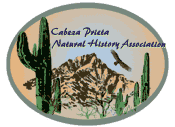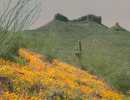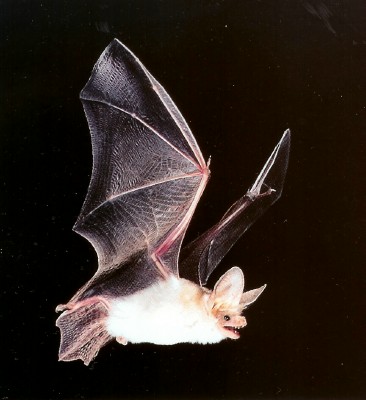
Cabeza Prieta Natural History Association
Sonoran Desert Mammals

Pallid bat
(Antrozous pallidus pallidus)

|
Diet: insectivorous, primarily
Color: light cream to light brown back and white belly Size: weight 20-35 grams (0.7-1.2 ounces) wingspan 37-41 centimeters (15-16 inches) Active Period: nocturnal |
The pallid bat is common in arid regions with rocky outcroppings, particularly near water. This gregarious species usually roosts in small colonies of 20 or more individuals in rock crevices and buildings, but occasionally roosts in caves, mines, rock piles, and tree cavities.
Relative to other bats, pallid bats emerge from roosts relatively late, but the time of emergence in the evening varies seasonally. Mothers and offspring may emerge and forage together. Pallid bats walk on the ground with a variety of strides and gaits, and they can hover or glide momentarily. They chiefly feed on large (2-7 centimeters or 1-3 inches in length) prey that is taken on the ground or, perhaps less frequently, in flight within a few meters of the ground or from the surfaces of vegetation.
One or two babies are born in May or June. Females hang upright during parturition, and newborns are held in the curled interfemoral membrane. This is a common species throughout most of its range.
Detailed diet: flightless arthropods such as scorpions, crickets, and centipedes, ground-roving insects such as darkling ground beetles, scarab beetles, predacious ground beetles, carrion beetles, and short-horned grasshoppers, prey gleaned from vegetation, including cicadas, katydids, praying mantids, long-horned beetles, and sphingid moths also known to eat lizards and rodents
This article is from "Bats of the United States", 1999, by Michael J. Harvey of Tennessee Technological University, J. Scott Altenbach of the University of New Mexico, and Troy L. Best of Auburn University. Published by the Arkansas Game & Fish Commission, in cooperation with the Asheville Field Office of the U.S. Fish and Wildlife Service.
Photo Credit:
Photo #1
Copyright Creative Commons
HTML & Programing by
Thomas R. Powell